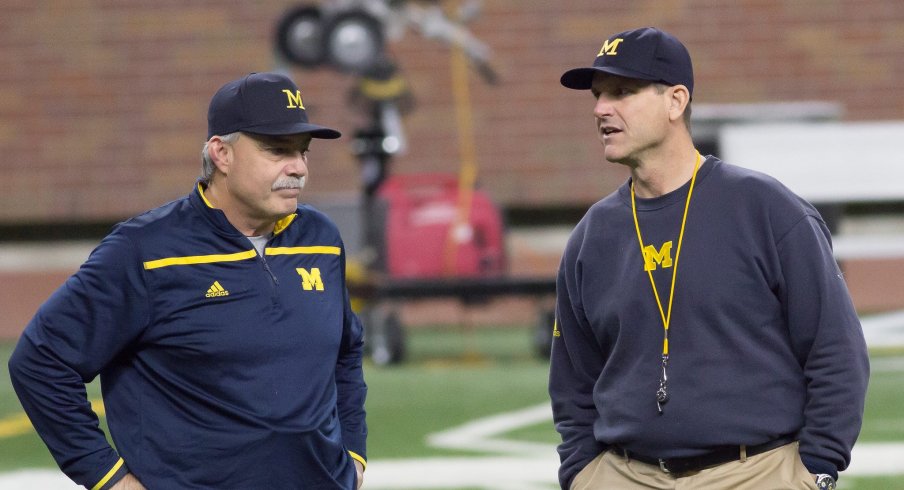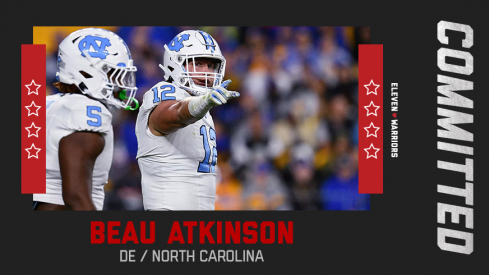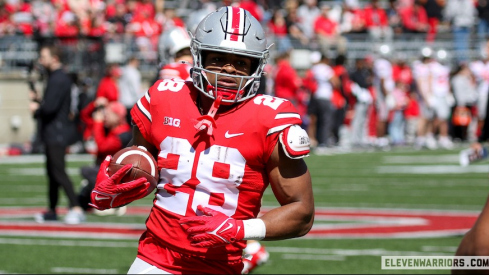Much to the dismay of Buckeye fans accustomed to holding the upper hand over their biggest rival, the 2016 Michigan Wolverines have returned their program to national prominence thanks in large part to their dominance on one side of the ball.
While the maize and blue defense has improved steadily over the past few years, finishing among the top 10 nationally in yards-allowed-per-game each of the past two seasons, the arrival of former Boston College coordinator Don Brown signaled the unit's elevation to an even higher level this fall. The addition of Brown to Jim Harbaugh's staff was highly praised at the time, given his ability to turn the Eagles into America's best defense statistically, despite facing high-octane attacks like Clemson, Florida State, and Louisville.
Since arriving in Ann Arbor, though, Brown has taken a good unit and made them even better. Not only does his talented secondary anchor America's best pass defense, a strong run defense puts the Wolverines atop the national rankings for total-yards-allowed through 11 games.
| Team | rush yds | pass yds | total yds | total yds/game |
|---|---|---|---|---|
| Michigan | 1195 | 1507 | 2702 | 245.6 |
| Alabama | 758 | 2021 | 2779 | 252.6 |
| Temple | 1490 | 1566 | 3056 | 277.8 |
| Ohio State | 1314 | 1755 | 3069 | 279.0 |
| Florida* | 1221 | 1600 | 2821 | 282.1 |
*Florida has only played 10 games, compared to 11 for all other teams listed
However, some have discounted Brown's new outfit, given they hype surrounding swiss army knife Jabrill Peppers. Peppers has become a Heisman candidate due to his contributions on offense and special teams, reminding many in the mitten state of the last player in maize and blue to win the award.
But Peppers is more than just a return specialist, acting instead as the queen on Brown's chess board and lining up all over the field. His most common role is similar to that of Buckeye 'SAM' linebackers like Darron Lee and Chris Worley, playing the alley between the tackle and a slot receiver in addition to lining up at either safety spot, inside linebacker, or as a cover corner.
As we see on tape, two skills in particular separate Peppers from most of his contemporaries: acceleration and tackling. The junior's ability to close on a ball carrier is truly elite, making holes in the running game disappear before a back finishes making a cut, or taking down a quarterback before he can get rid of the ball.
That athleticism is useful in any situation, which is why Brown moves him all over the field, whether shadowing a receiver, filling gaps in the running gap, or blitzing from any angle to rush the passer. Once there, the New Jersey native rarely fails to end the play, tallying 50 tackles while missing only four to this point in the season, with 15 of them coming behind the line of scrimmage.
“It’s almost criminal what we ask him to do,” Brown said in September. “He’s out playing press coverage on a No. 2 slot receiver. He’s in the blitz game. Then he’s playing static linebacker. We’ve got him all over the place, learning what we’re trying to do from a defensive perspective, and then he has other responsibilities other than defense.
But if Peppers is Brown's most versatile contributor, cornerback Jourdan Lewis may well be his most valuable. The cornerback anchors a secondary that favors man-to-man coverage more than any other in the country, thanks in large part to Lewis' ability to make opposing receivers virtually disappear.
Despite a small stature, standing only 5'10" and 170 lbs, Lewis has been dominant in this, his senior season, allowing only eight completions on 31 targets. But the All-American hasn't been the only member of Brown's secondary to carry his weight.
Fellow cornerback Channing Stribling has seen 52 passes come his way as opponents look to avoid Lewis, yet has been just as good as his more famous teammate, allowing only 16 completions. The duo of Stribling and Lewis has allowed only a single touchdown catch this season, giving their teammates and coaches the confidence to attack up front with reckless abandon.
On the majority of snaps, Brown will dispatch at least one additional blitzer, often dropping free safety Dymonte Thomas into a deep zone to create a 'Cover 1' scheme as the remaining Wolverine defensive backs lock up receivers. But the key to Brown's pressure is his ability to disguise who is blitzing and from where, creating more negative plays than any other team in the country, and leading the Big Ten in sacks.
Those sacks are not the result of one pass rusher dominating the opposition, though the defensive line is headlined by senior Taco Charlton, who has had a strong season and may even hear his name called in the first round of the NFL draft this spring. Instead, the pass rush has seen eight players tally three sacks or more, coming from every position in the front seven.
| Name | Position | Sacks |
|---|---|---|
| Taco Charlton | DE | 6.5 |
| Chase Winovich | DE | 5.0 |
| Chris Wormley | DE | 4.5 |
| Jabrill Peppers | OLB/S | 3.5 |
| Ben Gedeon | ILB | 3.5 |
| Mike McCray | ILB | 3.5 |
| Maurice Hurst | DT | 3.5 |
| Ryan Glasgow | DT | 3.0 |
While six or seven defenders often hover near the line before the snap, the most dangerous member of the front is clearly Peppers, whose aforementioned athleticism allows him to act as a 'spy' on the quarterback, blitzing only once a natural gap opens in front of him and closing quickly.
Such dominance against the pass has caused opponents to lean heavily on the run, though often with similar lackluster results.
In last year's regular-season finale with Ohio State, the Buckeyes gashed the Wolverines on the ground for 369 yards as Ezekiel Elliott and J.T. Barrett ran a number of option concepts to perfection. But this fall, along with Brown came his 'squeeze and pop' technique that allows his defensive ends to attack the read-option from the inside, staying square against a cutback on the handoff or chasing down the QB with help coming from the outside. That same mentality affects how they play outside runs, with Peppers often attacking the initial blocker and forcing the runner into the hands of a linebacker in 'force' support.
As detailed by MGoBlog in their autopsy of the bloodbath that ensued when the Wolverines visited Piscataway, New Jersey last month, the Scarlet Knights employed many of the same concepts found in Urban Meyer's playbook. Though the talent gap between Rutgers and Ohio State is vast, Brown's defense had no trouble playing downhill and stuffing many of the same plays that had given them so much trouble one year before.
However, there have been cracks in the foundation as of late. Iowa ran the ball effectively in their 14-13 upset win over the Wolverines two weeks ago, and Michigan State averaged over five yards-per-carry during their tilt last month. Many of the yards surrendered to L.J. Scott and the Spartans were the product of poor tackling efforts from Stribling and inside linebackers Mike McCray and Ben Gedeon, but Brown's defense was often caught out of position thanks to pre-snap motion that resembles what the Buckeyes have run a great deal recently.
Don't expect Brown to back down from what he knows best, though.
“These guys want you to line up in quarters and a static front and kick your you-know-what," Brown said, publicly signaling his intention to keep his man coverage schemes intact after allowing a high rushing total to UCF in September. "We’re not doing that. If it is, it’ll be over my dead body, OK? We’re going to stay aggressive, we’re going to stay focused, and we’re going to stay multiple.
But thanks to the efforts of their teammates, the weaknesses of Gedeon and McCray at linebacker had largely been overlooked until the loss in Iowa City. Though the secondary certainly lived up to its billing and the defensive line was solid, the middle of the Michigan defense was consistently attacked by Iowa running back Akrum Wadley in the passing game, using his athleticism to create separation against the slower defenders as he caught 5 passes for 52 yards.
But attacking the duo of inside linebackers didn't begin recently. Colorado forced the Michigan safeties to help on a number of horizontal concepts as the Buffalos manipulated the Wolverine man-coverage with motion and formation.
Many have expected Saturday's matchup to feature a heavyweight matchup between the top two playmakers in the Big Ten, Peppers and Buckeye "H" back Curtis Samuel. Yet both players are moved around the field so much by their respective coaches that their interactions may be relatively few.
However, given the magnitude of the contest and how important Samuel is to Meyer's game plan every week, Brown may look for ways to get Peppers and Lewis matched up with the Buckeyes' top threat more often. There will be opportunities for Samuel to exploit members of Michigan defense, but the Ohio State coaches will have to be creative in how they package those instances, ensuring that he'll be working against Gedeon or McCray whenever possible.
Ohio State's biggest weakness offensively has been the lack of a downfield passing game, so adding Michigan's blanketing pass defense shouldn't have too much of an effect on what Meyer and his staff will try to do. More likely, though, if the Buckeyes can find a way to control the line of scrimmage and establish a running game with Barrett, that may be enough for Ohio State to make it five consecutive victories over their arch-rival. Despite a poor throwing effort in East Lansing this past week, Barrett was Ohio State's best weapon because of his legs, picking up 122 yards on the ground including five third-down conversions.
With all eyes on The Game, the chess match between the Big Ten's best offense and defense has been anticipated for months. Both sides feature a great deal of future NFL talent, and have undoubtedly been holding back wrinkles and adjustments just for this contest. But while both teams will empty their playbooks on Saturday in Ohio Stadium, the difference between the two sides may only be a handful of plays.



